Introduction
In the digital age, the backbone of successful business operations lies in the effective management of Information Technology Infrastructure Services. These services encompass a range of critical components—hardware, software, networks, and facilities—that collectively enable organizations to navigate the complexities of modern IT environments.
As companies increasingly rely on technology to meet their operational goals and strategic objectives, understanding the intricacies of IT infrastructure becomes paramount. With significant growth projected in the IT Services market, particularly in regions like Brazil and Mexico, organizations must leverage comprehensive insights to remain competitive.
This article delves into the essential elements of IT infrastructure services, highlighting their role in fostering business agility, the various infrastructure models available, and the critical importance of cybersecurity in safeguarding organizational assets.
In an era where technology is constantly evolving, the ability to adapt and innovate hinges on a robust IT foundation.
Defining Information Technology Infrastructure Services
Information technology infrastructure services are the essential elements that underpin effective IT environments. These offerings encompass critical components such as hardware, software, networks, and facilities, all essential for the management and delivery of information technology infrastructure services to users and customers. By establishing a structured environment for data processing, storage, and communication, information technology infrastructure services empower organizations to harness technology efficiently in pursuit of their operational requirements and strategic objectives.
As Ankit Gupta, a Senior Research Analyst, notes,
Having worked on over 150 reports for Fortune 500 companies, my perspective emphasizes the blend of technical and managerial aspects that drive IT infrastructure success.
With Brazil and Mexico driving significant growth in the IT Services market, projected to expand by over 10% annually, the growth prospects are substantial. Comprehensive analyses of industry leaders such as Accenture, IBM, and Tata Consultancy Services reveal their strategic approaches and market shares, underscoring the competitive dynamics at play.
STS Consulting Group stands out as a leading IT consulting firm based in Austin, specializing in providing innovative technology solutions such as IT consulting, cloud solutions, and cybersecurity, tailored to enhance business growth and productivity. Our dedication to providing tailored IT strategies guarantees that entities can adjust to changing market needs. Therefore, comprehending IT support systems is not just theoretical; it is a vital element affecting a company's technological abilities and overall effectiveness in today's swiftly changing business environment.
Additionally, STS Consulting Group plans to leverage the projected growth in the IT Services market by focusing on strategic partnerships and cutting-edge solutions that differentiate us from competitors. Unlimited access to market insights, including statistics, reports, and usage rights, provides organizations with the necessary tools to navigate this complex environment effectively.
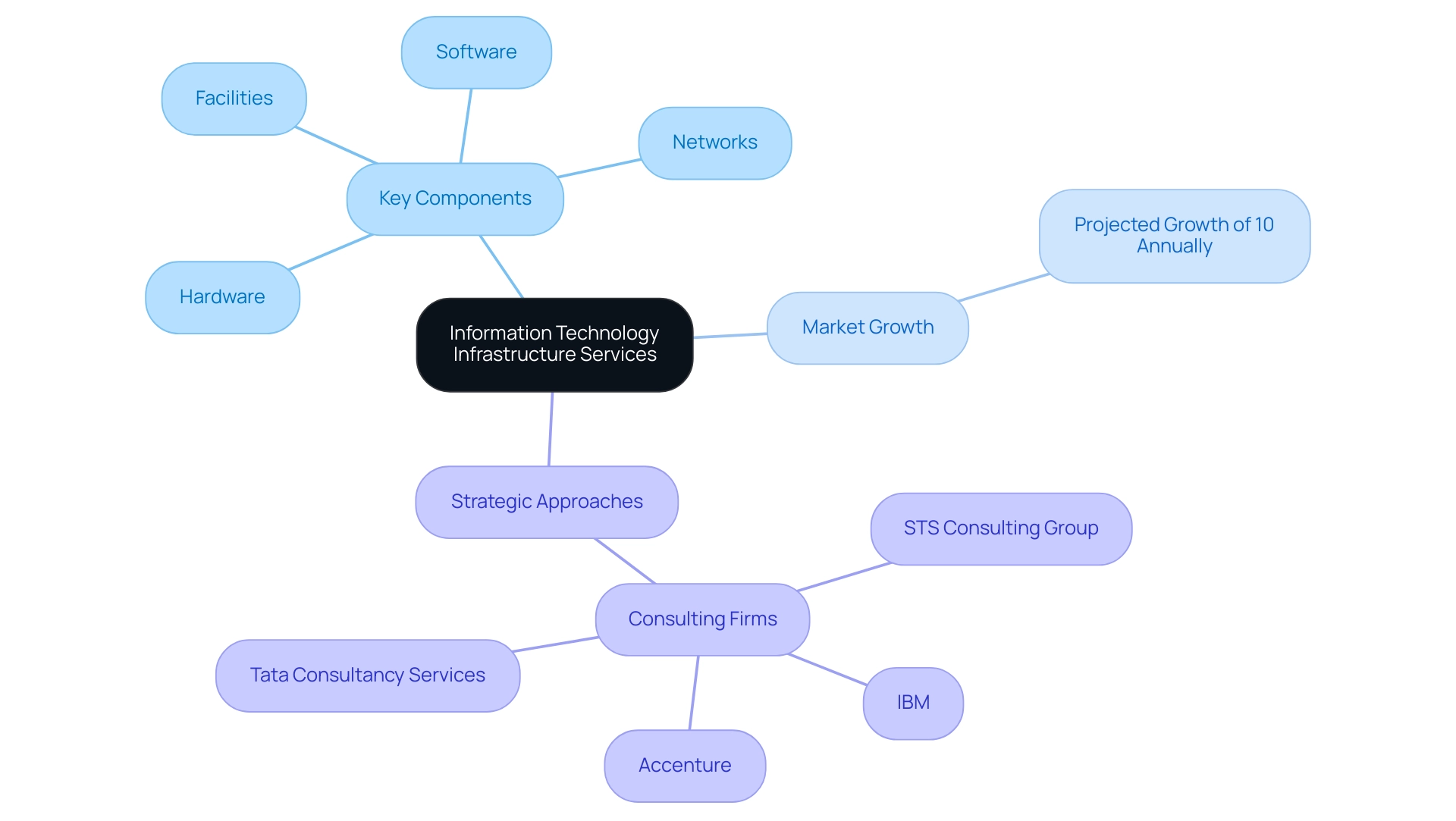
Key Components of IT Infrastructure Services
A comprehensive understanding of information technology infrastructure services hinges on the synergy between three key components: hardware, software, and network elements.
- Hardware serves as the backbone of IT operations, encompassing critical resources such as:
- Servers
- Storage devices
-
Networking equipment
These physical assets are vital for processing, storing, and transmitting data. -
Software, which includes operating systems, applications, and management tools, is essential for optimizing hardware performance and enabling users to execute necessary tasks efficiently.
-
Network components—specifically routers and switches—facilitate seamless connectivity and communication among devices, ensuring that data flows smoothly within the infrastructure. As organizations increasingly shift to network-based models, particularly in regions like Asia Pacific where computing adoption is surging, the interplay of these elements becomes even more crucial.
According to a recent report, in 2024, North America accounts for the largest market share in the IT Infrastructure Market, highlighting the region's significance in the industry. The shift towards cloud solutions is exemplified by the Asia Pacific case study, where major public cloud providers are expanding their data center presence, prompting many companies to move from traditional on-premise systems to cloud-centric models. Each component must function cohesively to establish a resilient information technology infrastructure services framework that aligns with organizational objectives and meets the demands of modern business operations.
As noted by IT experts, 'The integration of hardware and software is paramount for achieving operational excellence in today's digital landscape.' Understanding the dynamics of these components will be critical for CTOs aiming to leverage technology for competitive advantage.
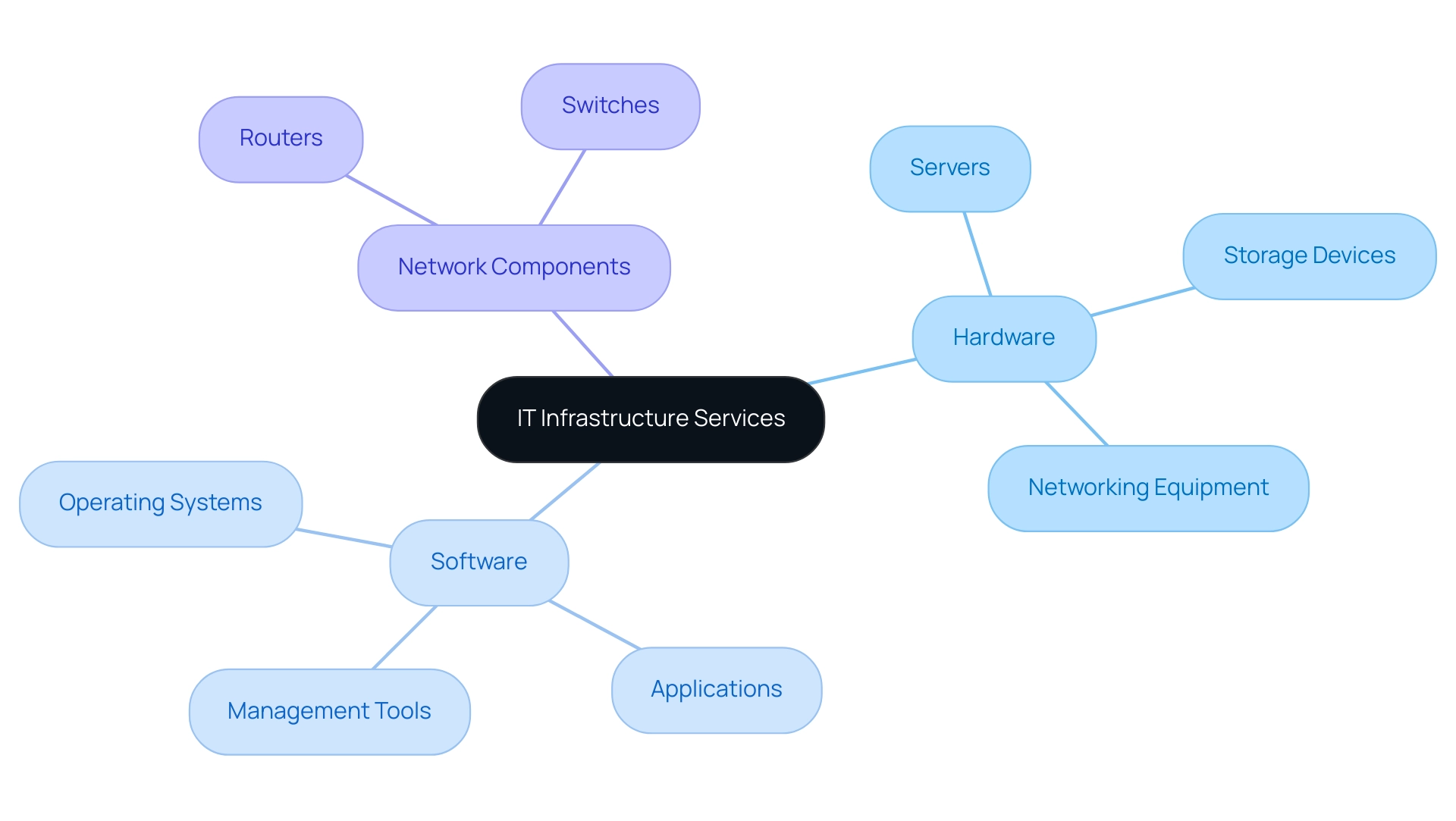
The Role of IT Infrastructure in Business Agility
Information technology infrastructure services are pivotal in fostering business agility by providing the flexibility and scalability needed to swiftly adapt to market demands. Organizations that prioritize investment in information technology infrastructure services can efficiently deploy new applications, adjust resources dynamically, and seamlessly integrate emerging technologies—all while avoiding significant disruptions. This heightened agility not only accelerates innovation but also enhances customer experiences and fortifies a company's competitive position in an ever-evolving landscape.
As pointed out by Andrew Young, Hybrid Strategy Lead, the development and execution of strategic initiatives in hybrid systems are essential for driving organizational growth and innovation. This viewpoint emphasizes that effective information technology infrastructure services go beyond simple support roles; they serve as a strategic facilitator of business success. Furthermore, CDW provides comprehensive support for organizations navigating the complexities of modernization by offering information technology infrastructure services, including licensing assessments and advisory workshops, to help optimize IT environments.
Recent industry reports indicate that companies with strong IT capabilities are better positioned to navigate complexities and capitalize on new opportunities, a trend evidenced by Google Cloud's IaaS offering, which has experienced remarkable growth of 63.7%, solidifying its status as a leading contender in the market.
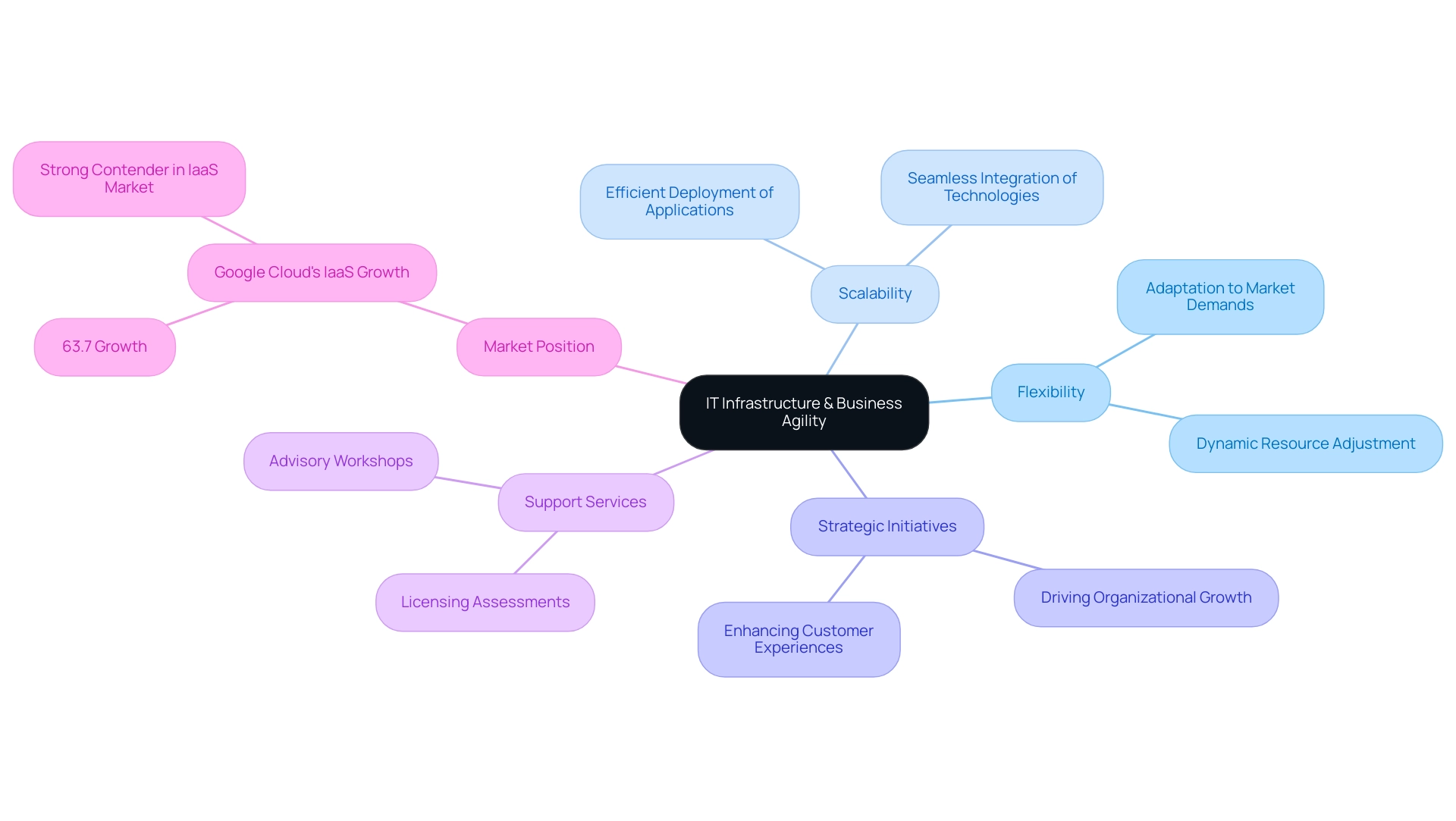
Types of IT Infrastructure: Traditional, Cloud, and Hybrid
Organizations typically function within one of three main IT framework models: traditional, online, and hybrid. Traditional frameworks depend on on-premises systems, requiring businesses to manage their own hardware and software within their facilities. While this model can offer a high degree of control, it often incurs significant costs and lacks the flexibility that modern enterprises demand.
Conversely, online frameworks employ remote servers reachable through the internet, allowing organizations to flexibly adjust resources and greatly lower capital costs. This transition towards online solutions is reflected in recent industry trends, including a remarkable 63.7% growth in Google’s Infrastructure as a Service (IaaS) offerings. However, it is important to recognize the challenges related to online systems; misconfiguration of web services is the leading cause of internet-based data breaches.
Mariusz Michalowski, Community Manager at Spacelift, emphasizes the importance of automation and open-source solutions in navigating these challenges. At the same time, hybrid systems combine the advantages of both traditional and online models, enabling businesses to keep critical applications on-site while utilizing online resources for extra scalability and adaptability. Real-world examples, such as Drift reducing its annual cloud cost by $2.4 million and Applause achieving a 23% drop in cloud spend, illustrate the potential for effective cloud cost management.
Each type of framework offers unique benefits and difficulties, highlighting the importance for entities to carefully assess their particular requirements and strategic objectives.
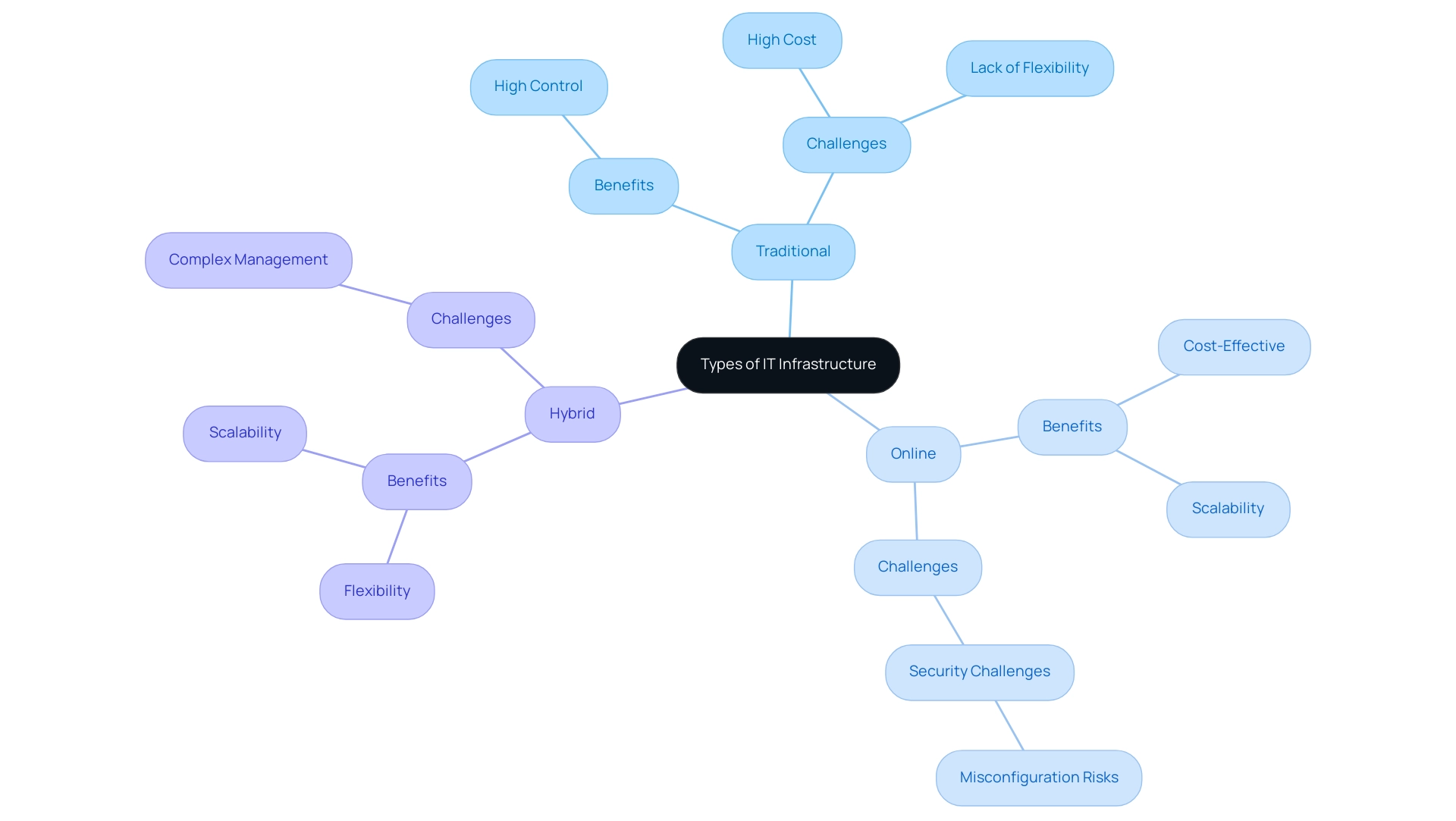
Ensuring Security in IT Infrastructure Services
Securing information technology infrastructure services is critical for protecting sensitive data and ensuring operational continuity. The urgency of this need is emphasized by the alarming statistic that security breaches have impacted 20 percent of entities during the pandemic, highlighting the necessity for robust cybersecurity measures. A comprehensive multi-layered security approach is essential, incorporating:
- Firewalls
- Intrusion detection systems
- Regular security audits
to create a fortified defense against threats.
Furthermore, employee training on cybersecurity best practices is vital, as human error remains a significant vulnerability in security frameworks. Compliance with industry standards and regulations, such as GDPR and HIPAA, is equally important in establishing a secure IT environment. The enforcement of GDPR has intensified, leading to record fines exceeding €1.6 billion in 2023, with companies like Meta, TikTok, and Spotify facing substantial penalties for violations.
This reinforces the critical role of compliance within cybersecurity strategies. As Chuck Brooks emphasizes, the statistics surrounding cybersecurity remain alarming, and entities must consider these insights while developing their 2024 security plans. With global spending on cybersecurity products and services projected to reach $1.75 trillion from 2021 to 2025, it is imperative that organizations adopt effective strategies to remain resilient against the evolving cyber threats.
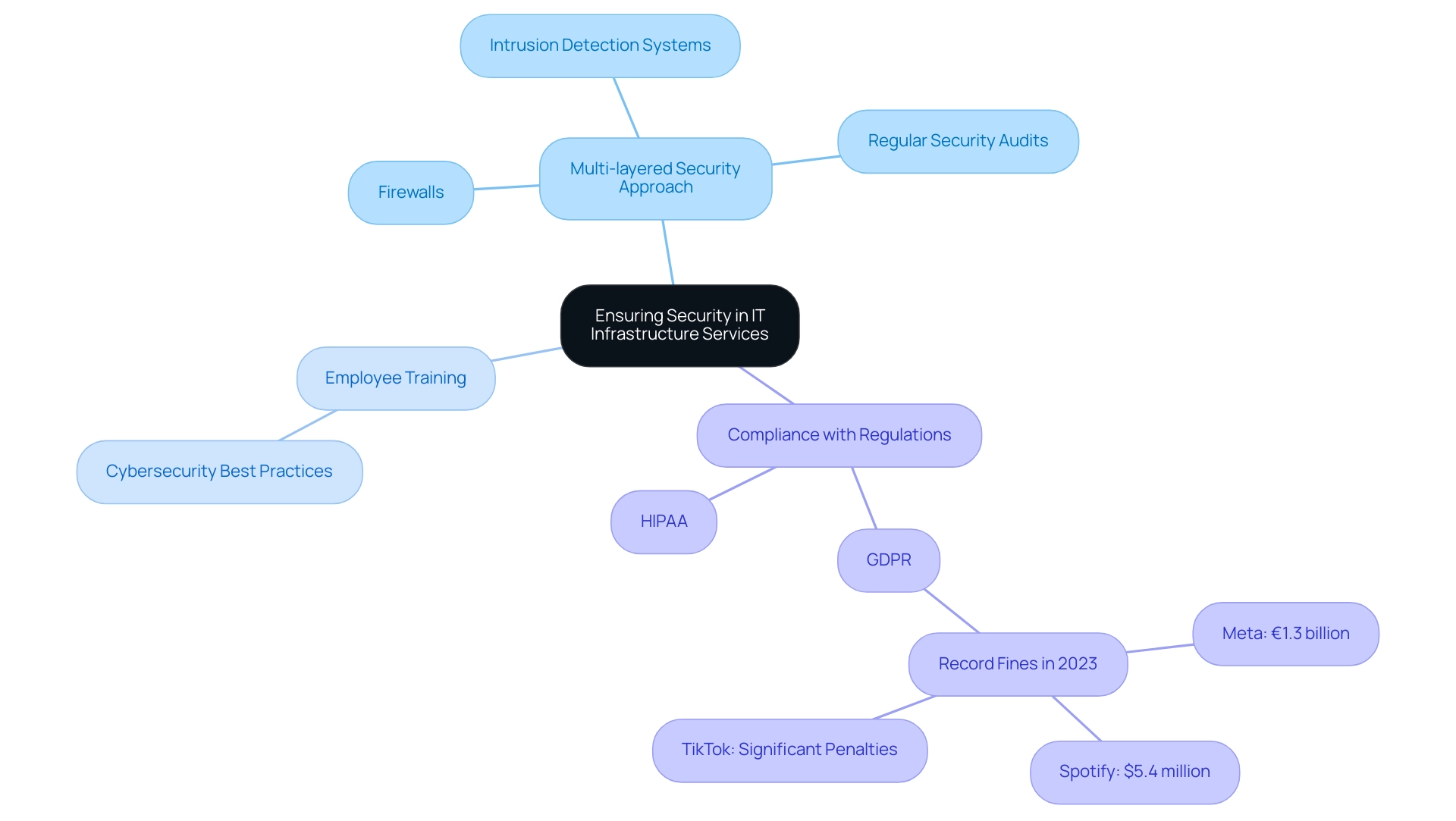
Conclusion
The exploration of Information Technology Infrastructure Services reveals their integral role in shaping effective IT environments that drive business success. By examining the essential components—hardware, software, and networks—it becomes clear that a harmonious integration of these elements is crucial for operational efficiency. As organizations increasingly pivot towards cloud-centric models, understanding these dynamics is vital for leveraging technology to achieve competitive advantage.
Furthermore, the significance of IT infrastructure in fostering business agility cannot be overstated. The ability to swiftly adapt to market demands through modern, flexible systems not only enhances innovation but also improves customer experiences. This positions organizations favorably in a rapidly changing landscape, emphasizing that IT infrastructure is a strategic enabler rather than merely a support function.
As companies navigate the various infrastructure types—traditional, cloud, and hybrid—they must weigh the benefits and challenges each model presents. The shift towards cloud solutions, while offering scalability and cost efficiency, necessitates a careful approach to security and risk management. The alarming rise in cybersecurity threats underscores the importance of robust security measures and compliance with regulatory standards to protect sensitive data.
In conclusion, a comprehensive understanding of IT infrastructure services is essential for organizations aiming to thrive in today's technology-driven marketplace. By investing in effective infrastructure strategies, businesses can not only optimize their operations but also position themselves for sustainable growth and resilience against future challenges.




